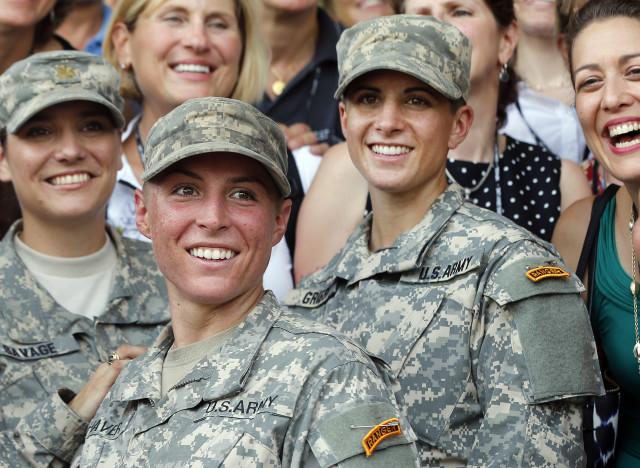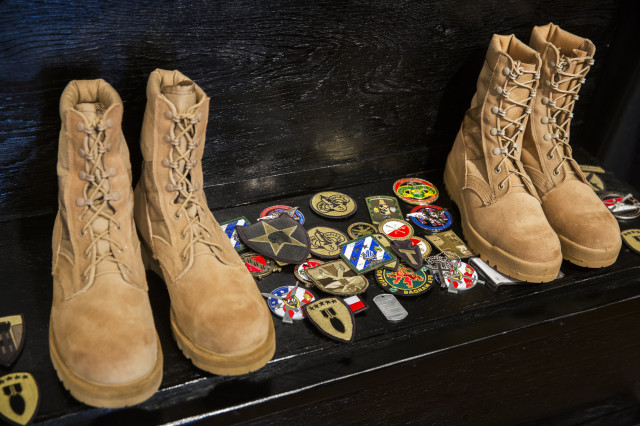Most of those running for president say more must be done to defeat ISIS. And more usually equals more military might. In the United States, military service is a choice, not a requirement. While all men must register with the Selective Service System at age 18, there has not been a military draft in 42 years. But that has not stopped some from suggesting its return for reasons ranging from raising the competency level of the military to improving the country’s social fabric. Many argue that compulsory service would make politicians think twice about going to war. Does the U.S. has the military it needs? And what are the needs of the military it has?
The Military’s Real Problem: Fewer Americans are Joining
John Spencer – Politico
This change [women eligible for combat roles] is going to help the military in any number of ways: It’s a step toward greater fairness, and it makes a new talent pool available to combat positions. But before we get too complacent, the Army has another challenge in front of it that opening the door to women is just one small step toward solving: It is understaffed for the challenges it faces, and faces an even bigger recruiting struggle ahead.
U.S. Army First Lt. Shaye Haver, center, and Capt. Kristen Griest, right, pose with other female West Point alumni after becoming the first women to graduate from Army Ranger school. Aug. 21, 2015, at Fort Benning, Ga. (AP)
The number of Americans eligible to serve in the military is dramatically shrinking, leaving the Army at its smallest size in over 75 years and forcing units to rely on unstable and unprepared servicemen. That puts both our military troops and the country at risk.
This problem is going to only get worse: The Department of Defense estimates that 71 percent of the roughly 34 million 17- to 24-year-olds in the U.S. today would fail to qualify based on the current enlistment criteria because of physical or mental health issues, low educational scores or major criminal convictions.
Why America Needs the Draft
Kathleen Frydl – The American Interest
Almost every important American social movement of the recent past has articulated in one way or another through U.S. military service policy. The modern Civil Rights movement won a landmark desegregation order from President Harry S. Truman in 1948, the final, most seminal, and most cherished of its exclusively Executive Branch victories. The anti-Vietnam War protest movement was intimately connected to the draft, especially as combat dragged on beyond the reprieve granted by a typical II-S student deferment. The buoyant hopes of second-wave feminists who sponsored the Equal Rights Amendment began to falter when opponents forced voters to contemplate “drafting mommy.” And one of the signal achievements of the gay civil rights movement was the end of the military’s “Don’t Ask Don’t Tell” policy in 2011.
Yet despite its importance as a staging area for great social struggles over more than half a century, U.S. military manpower policy receives relatively little attention.
#SecDef Carter huddles with airmen after landing in Afghanistan & thanks them for their service this holiday season pic.twitter.com/OipHpoznAy
— U.S. Dept of Defense (@DeptofDefense) December 18, 2015
The Tragedy of the American Military
James Fallows – The Atlantic
At the end of World War II, nearly 10 percent of the entire U.S. population was on active military duty—which meant most able-bodied men of a certain age (plus the small number of women allowed to serve). Through the decade after World War II, when so many American families had at least one member in uniform, political and journalistic references were admiring but not awestruck. Most Americans were familiar enough with the military to respect it while being sharply aware of its shortcomings, as they were with the school system, their religion, and other important and fallible institutions.
Now the American military is exotic territory to most of the American public. As a comparison: A handful of Americans live on farms, but there are many more of them than serve in all branches of the military. (Well over 4 million people live on the country’s 2.1 million farms. The U.S. military has about 1.4 million people on active duty and another 850,000 in the reserves.) The other 310 million–plus Americans “honor” their stalwart farmers, but generally don’t know them. So too with the military. Many more young Americans will study abroad this year than will enlist in the military—nearly 300,000 students overseas, versus well under 200,000 new recruits. As a country, America has been at war nonstop for the past 13 years. As a public, it has not. A total of about 2.5 million Americans, roughly three-quarters of 1 percent, served in Iraq or Afghanistan at any point in the post-9/11 years, many of them more than once.
If I were writing such a history now, I would call it Chickenhawk Nation, based on the derisive term for those eager to go to war, as long as someone else is going. It would be the story of a country willing to do anything for its military except take it seriously.
I’d Go With Them
Rich Galen – Townhall
It is unfortunate, but no surprise, that everyone running for office, working for someone running for office, or writing about someone running for office is searching for the perfect rhetorical and political response to Paris.And, as we’ve learned, putting troops and guns into a region is a hell of a lot easier than taking them back out.If we increase our military presence in the Middle East in response to the growing threat let’s not hide behind “boots on the ground” or any other euphemism.Let’s tell the truth: We are going to send young men and women into battle. Again. Some of them will be killed. Many will be injured. Again.
Patches left by U.S. and other ISAF member country soldiers are seen on a step after a memorial for Specialist Wyatt Martin and Sergeant First Class Ramon Morris at Bagram Air Field in the Parwan province of Afghanistan December 23, 2014. Specialist Martin and Sergeant First Class Ramon were killed on December 12th by an improvised explosive device while on patrol near Bagram Air Field. Picture taken December 23, 2014. (REUTERS
The One Percent Problem
Harvey M. Saplosky – E-International Relations
Fifteen percent of 200 million would produce a military of 30 million, a bit large, one must say, for less than all out global warfare, the world we are in now. But even two percent produces a military of four million people; a third larger than the military on active duty during the 1960s when the Soviet Union was being confronted globally as well as a major war was being fought in Vietnam. Each year about four million Americans reach the age of 18. Currently, the American military needs less than 200K of them to volunteer for active duty or the reserves to maintain its numbers. With that pool, the military can insist on a high school education for enlisted personnel and a college degree for officers. Avoided are the medically unfit, those with serious criminal records, and those who would chafe under the discipline required.
Of course, the argument isn’t that all of the age group should serve in the military. Rather it is that some form of public service should be required of all. But what would the government do with four million 18 year olds each year?




